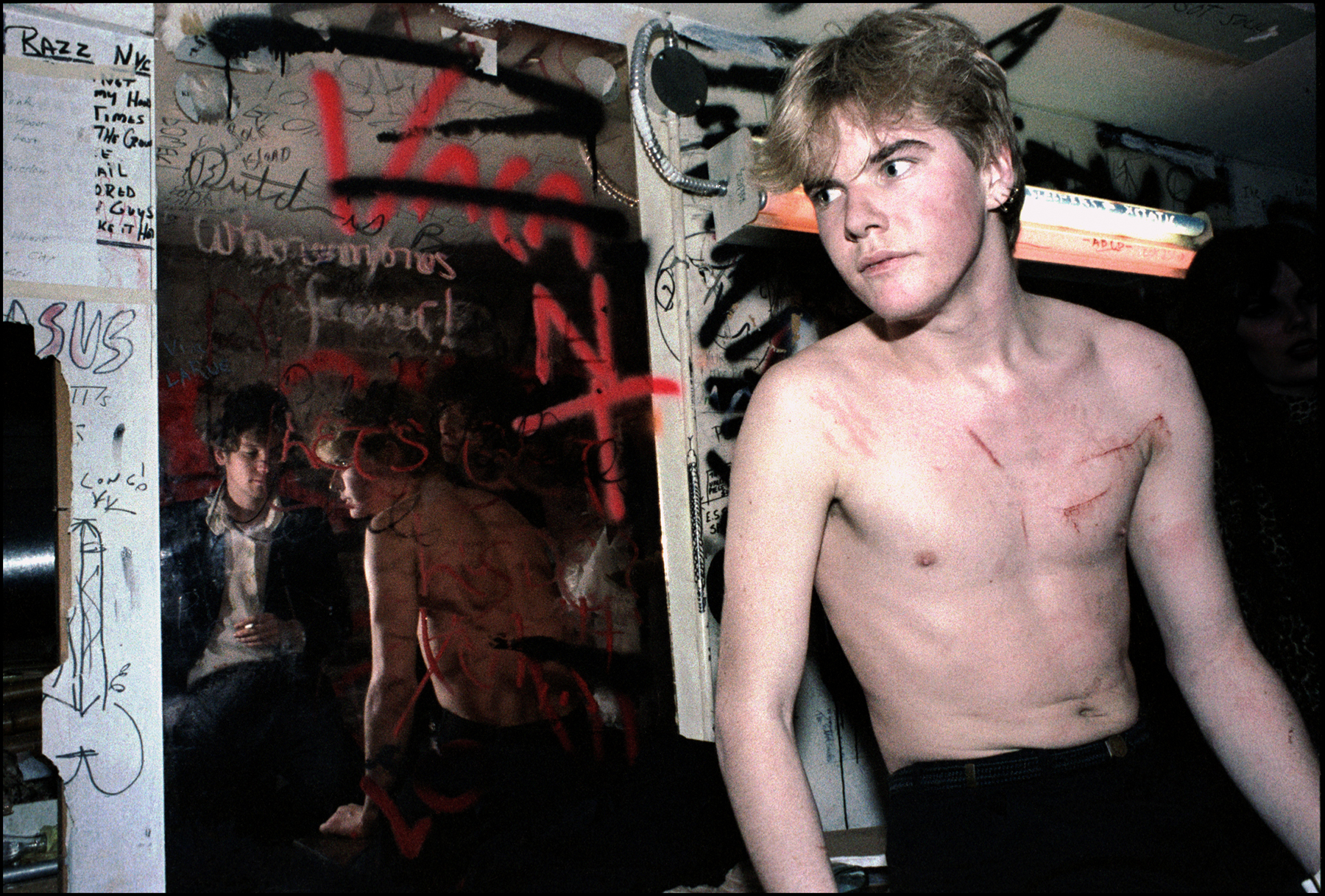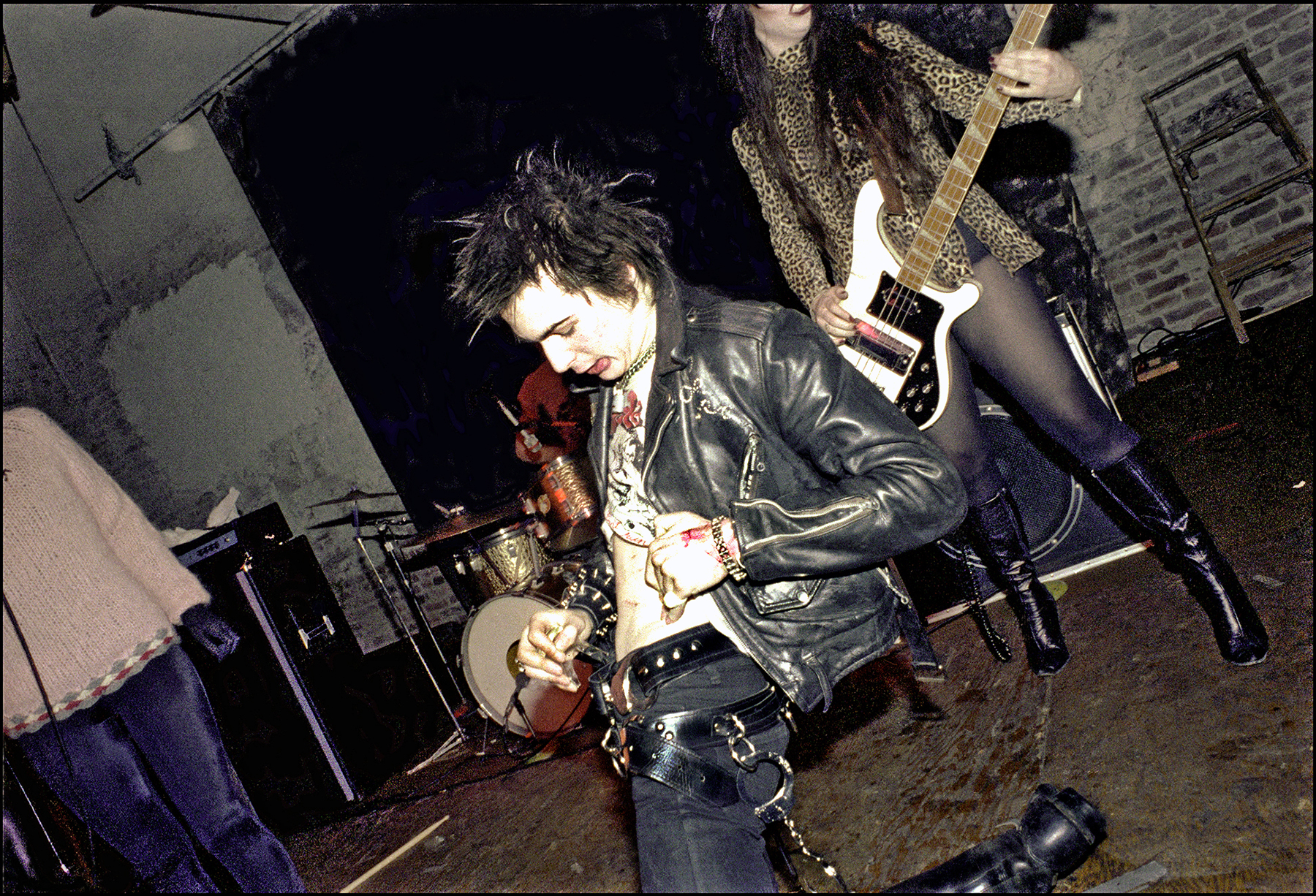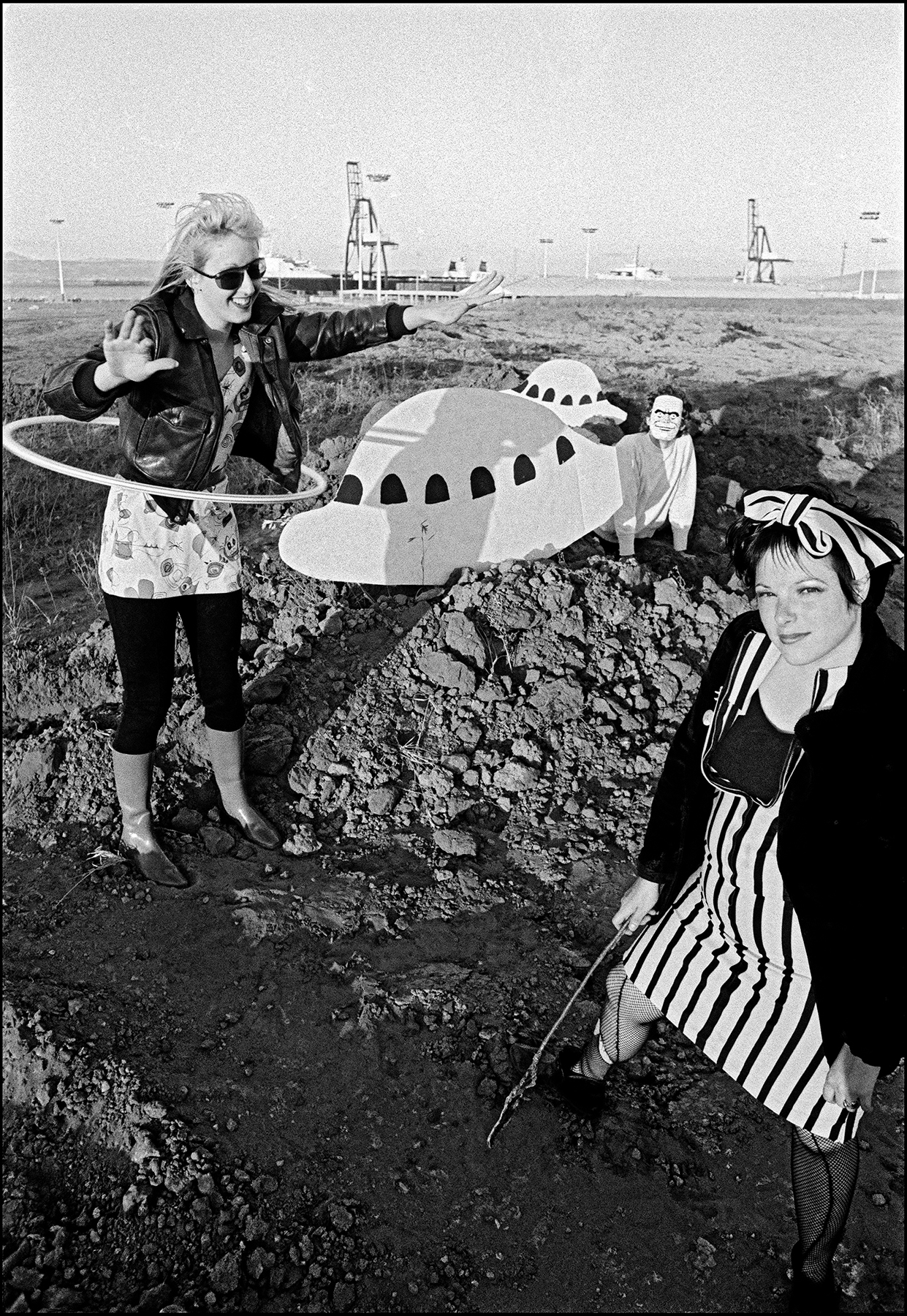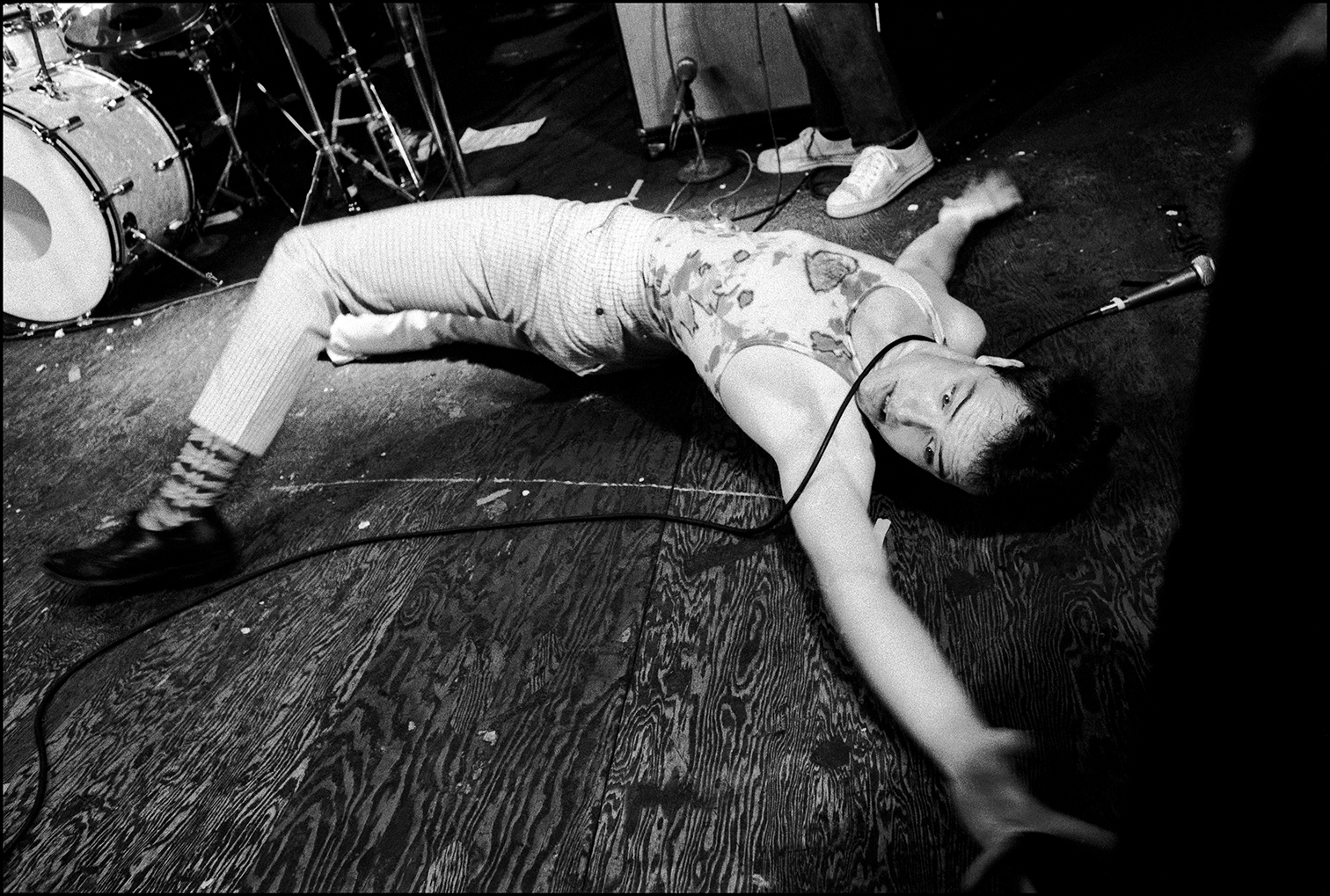The first time I saw Ruby Ray’s work was when I googled “punk” as a teenager. I would scroll through scans of the legendary punk zine Search and Destroy with photos of X, Darby Crash, and The Cramps — all the bands I grew up loving that inspired me to dye my hair, buy a studded collar, and pick up a guitar. I felt like I was there. And it wasn’t just because I wished it. It was Ruby’s photos — lively black and white (and occasionally, color) images that didn’t just capture a moment, but catapulted you into it. I got the same feeling flipping through her new book, Kalifornia Kool.
Shot between 1976 and 1982 in San Francisco, the book documents the city’s underground punk scene, and all the famous — and not-so famous — faces that made their way through it. From photos of LA punk icon Alice Bag, to Devo, to San Francisco’s own local legends The Mutants, to Sid Vicious, Ray was there for everything, either sitting backstage or front row. As the main photographer for Search and Destroy, she had a unique view of the people around her, shooting them not only as a fan, but as a member of the movement.
“To us, it was a revolution,” she said about punk. “I had finally found my people.”
And that sentiment shows in Kalifornia Kool with photos of X’s John Doe and Exene Cervenka at the Palladium, Vicious in a stairwell, and The Mutants at a local dump. Ray photographed not just the people of punk, but it’s brash and unapologetic energy, one that’s as loud on X’s Los Angeles or The Germs Forming as it is in her work.

Below, the photographer tells i-D how she fell in love with the punk scene and the crazy stories behind some of her favorite photos in Kalifornia Kool.
How did you get into punk? Were you always interested in photography?
I was taking photos for about two years before I got involved with [V.] Vale, who was the editor of Search and Destroy Magazine. I was looking for something I could do — something that could inspire me with my photography — and he came into Tar Records, where I was working, with the first issue of Search and Destroy. I literally ran after him and asked, ‘Don’t you need more photos?’ and that’s how I started photographing for Search and Destroy. But before that, I had always been interested in music, and I always liked Patti Smith. After I saw The Dills [perform] for the first time, I was totally sold. Music had just been so dull, you know? After the hippies, disco came along and it was all just mind-numbing. There was just nothing in it for me — not until I found punk.
What was it about the music — and punk, in general — that drew you in?
Just that it was so in the moment and that it was a freeing of the spirit. And it was way more ecstatic and lively than something like The Eagles. When I saw The Dills, it was 1975, and I was instantly like, ‘Fuck everything else. This is what I’m going to do now.’
Tell me about the pictures in Kalifornia Kool. You took them during the period of 1976 to 1982 — how old were you, where were you living, and what was going on in your life at that time?
I moved to San Francisco in 1974 and NYC in 1982. At that time, I was working with Vale and pretty much our whole lives revolved around Search and Destroy. It was an incredible period — we worked really hard, and we got to meet all the most interesting people from the punk era. We even had Jello Biafra from the Dead Kennedys sleeping on our living room floor when he ran for mayor of San Francisco [in 1979]. And he actually came in fourth!

Some of my favorite photos from the book are the ones you took of The Cramps at the Napa State Mental Hospital. Those pictures — and the video of that performance — have become totally iconic. At the time, did you realize you were shooting something special?
I kind of thought it was important, but at the same time, nobody cared about us punks. We weren’t popular, and LA was getting way more write-ups than the San Francisco scene. We were really just doing our own thing. When we did the Napa show, hardly anybody knew about it — I was only there because I was friends with The Mutants who played before The Cramps that night. That show was incredible — we didn’t know if they’d like us or try to kill us, but everybody loved it.
But did you know that what you were taking pictures of was going to become this huge cultural movement, or were you just taking pictures of your friends?
We knew it was a movement. So, we were shocked when nobody paid attention. But I knew I was taking good photographs, and I was an ambitious artist who worked a lot, so I saved my negatives because I thought they were special. Though, honestly, I thought the photos would just languish in obscurity until I got my first book out, which wasn’t easy. It took me nine years.
Looking through the book, are there any images you especially love?
I have a story behind every photo, but one of my favorites is The Mutants at the dump. At the time, I was really inspired by The Situationists, which was a political movement in France from the 60s that was an in-topic with the punks back then. One of the things they did was to wander the city without going from point A to B, just gaining inspiration. So, I decided to go to the dump. The sun was going down, and everyone was finding all sorts of crazy junk, like a box of artist’s paint and the hula hoop. I remember that exact moment: I was standing on a little mound of dirt and Sue was doing her little hula hoop in front of the band, who had just brought out this spaceship as a prop.
Another one of my favorite photos, which I actually hated at the time, is the one of DEVO when they had just came out with Duty Now for the Future. This was taken where the convention center is [in San Francisco], but back then it was just a giant empty lot. I was thinking of the Russian Constructivists when I took the photo, which is why I had them pose like that.
What about the photos of Sid Vicious?
In January of 1978, I photographed Sid Vicious in San Francisco right after the Sex Pistols played their last show. That show was great because it was the Sex Pistols, but it was also kind of ruined because all of these suburban kids came out. Suddenly, thousands of people were there, whereas the usual punk scene in San Francisco was maybe about 200 people we all knew. I hadn’t even brought my camera, because Bill Graham [the Sex Pistols concert promoter] was not letting anybody backstage to take photos unless they were ‘designated photographers,’ and nobody really knew me back then. But backstage, they were shaking up open beer bottles with their thumbs over the top and spraying it everywhere, and they turned backstage into a beer slip-and-slide. Everybody was doing it — all of the Sex Pistols, The Avengers and The Nuns. Of course, Bill didn’t like it, so it didn’t last very long.
But the next day, we figured they would all go to the Mabuhay [Gardens] because that was the only punk club in town. The Bags and The Germs were playing that night, and of course, they came. Steve Jones walked in first by himself, and Brandon Mullen from The Masque was there, and decided to start the night off by running up to Steve with a full drink, pretending to trip, and throwing it at Steve’s jacket. He had this beautiful red coat, and totally kept his cool. After a while, Sid came in with the girls from the LA band The Plungers, and he walked up to the front and sat on the stage during The Bags performance. He looked very bored — like he didn’t care what was going on around him — and he grabbed a piece of glass off the stage and started cutting himself. The Bags ignored him, and he got tired of it — or he was in a lot of pain from slicing open his stomach — and left. After a few minutes, Vale and I ran backstage and I asked ‘Sid, can I take your picture?’ He told me yes, but to hurry up. I ended up taking two photos in about thirty seconds. Then Darby from The Germs got on stage, and it was almost like a battle of the minds between him and Sid, like who could be the most dangerous. So, he cut himself up too.

Why did you shoot primarily in black and white? Was it a stylistic choice?
Absolutely. Also, I developed all of my own photos and you had to send color pictures in [for development], which took about a week. The week spent waiting for the colored photos of Sid from that night was torture, because I didn’t know if any of them would even turn out. When I got them back, I realized I had captured this whole ‘Madonna and The Child’ thing with Sid and Hellin [Killer], which I’m really proud of.
What’s the story behind the photo of William Burroughs? In a lot of ways, it fits in with the rest of the book, because Burroughs is kind of like the first punk. But it’s also different, aside from not being of a band, because it’s a posed portrait, whereas your other images are mostly candid or live performance shots.
Burroughs was a huge inspiration for us, especially because he was talking about mind control by the government — an issue that we were very interested in. But we were working on a book of his interviews, so Vale asked me to take the photo and I was obviously thrilled. We brought the gun, which worked because Burroughs was very interested in shooting, as were a lot of the punks, who would go down to the shooting range all the time. I actually went once, but it wasn’t my scene — it was too loud for me. I mean, punk is loud, but a gunshot is different.
By the time the 80s started, punk had become a mainstream phenomenon, so many of the underground punks turned to post-punk and hardcore. Did you start to notice a difference in the photos you took during that time?
Of course. In the beginning, it was so exciting and new, but after the whole Sex Pistols debacle in 1978, we stopped printing Search and Destroy. Shortly after, we started RE/Search Magazine, which was, in the beginning, similar to Search and Destroy, but bigger. At that time, people were starting to play post-punk and industrial, and the music in the scene didn’t have to be just fast and loud.
What do you think separated Search and Destroy and RE/Search from the countless other fan zines from that time?
Search and Destroy was loosely based off of this old hippie magazine called The Oracle. Vale, being even older than me, was a hippie himself, and was really inspired by The Oracle and Interview Magazine in New York CIty, in which Andy Warhol would casually interview people. My inspiration was early Rolling Stone, which I needed to read every single issue of, cover-to-cover back in 1969 or 1970 to know anything about what was going on. I graduated from high school in 70, and seeing Annie Leibovitz’s photo of John Lennon and Yoko Ono with him laying on top of her on the cover — that was jaw-dropping to me. I just wanted to figure out how she did it.
But we took all of our own photographs and we’d type out all of our interviews on a typewriter. Can you believe that? It was just such an easy method of getting information out there. Then other people saw that they could do it too, so all these other little zines started popping up. Also, it’s hard to imagine, but Xerox was the new technology back then, which allowed everyone to do things themselves. That definitely was a huge part of it — because punk was DIY.

How do you think your work has changed since then?
I don’t really do photography aymore. Occasionally I’ll use my cell phone to get a really good shot, but I lost interest in the digital age. Even when I was doing projection shows, I was using slide film and a slide projector. They stopped making those, too — it’s like everytime I find something I love they take it away. But I just really lost interest in the process. I was pretty developed at 25 — I had a lot of technique under my belt, my images always had depth, and I was very aware of what I was doing. I wanted to use technology to alter my viewer. And with the punk photos, I always enjoyed watching people and trying to understand them. I never really realized how big of a part that played in my photography until now, when I look back.
Do you think you were able to express yourself — and capture that time period — through photography in a way that you might not have been able to through another medium?
I consider myself to be very creative, and picking photography was purely accidental — my boyfriend at the time had his friends give me a camera. But before that, believe it or not, I was making clothes. As far as photography goes, there’s just something about the film — it’s silver and you can see positives and negatives at the same time. I always used to compare film to sex — you’re just waiting and waiting, and seeing the final photo is like having a huge orgasm.

